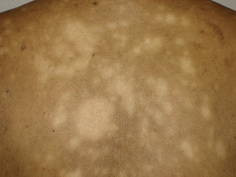Definisi
Granulomatosis dengan poliangiitis (sebelumnya dikenal dengan nama Granulomatosis Wegener) adalah suatu penyakit langka akibat peradangan di dalam jaringan yang penyebabnya tidak pasti. Area yang paling sering terkena Granulomatosis termasuk sinus, paru-paru, dan ginjal, tetapi daerah lain pun dapat terkena.
Terjadi kondisi yang disebut peradangan granulomatosa di tubuh, yaitu suatu jenis peradangan yang terjadi dalam waktu lama dan ditandai oleh menonjolnya suatu kumpulan sel. Selain itu, terjadi juga peradangan pada pembuluh darah (vaskulitis). Kombinasi kedua kondisi ini dapat merusak sistem organ.
Vaskulitis adalah istilah umum yang mengacu pada peradangan pembuluh darah. Saat meradang, pembuluh darah bisa menjadi lemah dan meregang membentuk aneurisma (suatu pembengkakan atau penonjolan abnormal pada dinding pembuluh darah). Peradangan juga bisa membuat pembuluh menjadi sangat tipis sehingga pecah dan terjadi pendarahan ke dalam jaringan. Vaskulitis juga dapat menyebabkan penyempitan pembuluh darah hingga menutup pembuluh seluruhnya.
Penyebab
Penyebab granulomatosis dengan poliangiitis masih belum diketahui dengan pasti. Penyakit ini tidak menular, dan tidak ada bukti bahwa penyakit tersebut diturunkan dalam keluarga.
Kondisi ini dapat menyebabkan peradangan, penyempitan pembuluh darah, dan terbentuknya suatu kompleks peradangan yang berbahaya (granuloma). Granuloma dapat merusak jaringan normal, dan penyempitan pembuluh darah yang terjadi bisa mengurangi jumlah darah serta oksigen yang mencapai jaringan dan organ di tubuh Anda.
Granulomatosis dengan poliangiitis bukanlah suatu bentuk kanker, tidak menular, dan biasanya tidak terjadi dalam keluarga. Bukti dari penelitian sangat mendukung ide bahwa sistem kekebalan tubuh memainkan peran penting dalam terjadinya penyakit ini sehingga sistem kekebalan tubuh bisa menyebabkan pembengkakan serta kerusakan pembuluh darah dan jaringan.
Faktor Risiko
Granulomatosis dengan poliangiitis dapat terjadi pada semua usia. Namun, penyakit ini paling sering menyerang individu dalam rentang usia 40-65 tahun. Distribusi penyakit ini pada kedua jenis kelamin hampir sama, namun terdapat sedikit kecenderungan untuk terjadi pada pria.
Gejala
Gejala granulomatosis dengan poliangiitis akan bervariasi di antara pasien bergantung dengan derajat keparahannya. Tanda-tanda umum yang bisa ditemukan pada penyakit ini bisa meliputi:
- Kehilangan selera makan
- Penurunan berat badan
- Demam
- Kelelahan
Sebagian besar pasien pertama kali menyadari munculnya gangguan pernapasan. Gejala mungkin termasuk:
- Hidung berair terus-menerus atau pembentukan kerak dan luka pada hidung
- Nyeri di hidung atau wajah
- Mimisan atau lendir dari hidung yang tidak biasa
- Batuk yang bisa disertai dahak berdarah karena peradangan saluran napas
- Rasa tidak nyaman pada dada yang dapat disertai atau tanpa sesak napas
- Perubahan suara, mengi, atau sesak napas bila terjadi peradangan pada trakea
Bisa ditemukan gejala-gejala peradangan lain seperti:
- Peradangan telinga tengah (otitis media), nyeri, atau gangguan pendengaran
- Peradangan mata dan/atau adanya tekanan di belakang mata, membuat mata sulit digerakkan, dan peradangan bisa disertai atau tidak disertai kehilangan penglihatan
- Nyeri otot atau sendi karena suatu peradangan
- Ruam atau luka pada kulit
- Peradangan pada ginjal
Diagnosis
Diagnosis dari granulomatosis dengan poliangiitis dapat ditegakkan melalui proses wawancara medis, pemeriksaan fisik, dan pemeriksaan penunjang. Pada wawancara medis, dokter akan bertanya mengenai keluhan utama pasien dan keluhan-keluhan yang menyertai, riwayat penyakit sebelumnya, riwayat penyakit keluarga, dan riwayat pengobatan yang sudah dijalani. Gejala yang ditemukan bisa menyerupai gangguan lainnya dan hal ini dapat menyulitkan diagnosis.
Selanjutnya dilakukan pemeriksaan fisik berupa pemeriksaan tanda vital yakni tekanan darah, nadi, suhu tubuh, dan laju napas. Kemudian dokter akan melakukan pemeriksaan fisik dari ujung kepala hingga ujung kaki.
Pemeriksaan penunjang merupakan pemeriksaan yang penting dalam mendiagnosis granulomatosis dengan poliangiitis. Pemeriksaan-pemeriksaan yang bisa dilakukan antara lain:
Pemeriksaan Laboratorium Darah
Ada rangkaian pemeriksaan laboratorium yang dapat dilakukan untuk memeriksa:
- Tanda-tanda peradangan, seperti protein C-reaktif (CRP) atau laju endapan sel darah merah, bisa ditemukan kadar atau hasil yang tinggi pada pemeriksaan ini
- Antibodi sitoplasma anti-neutrofil, yang muncul dalam darah kebanyakan pasien granulomatosis aktif dengan poliangiitis
- Anemia, yang umum terjadi pada orang dengan penyakit ini
- Fungsi ginjal, bila terjadi peradangan pada ginjal bisa ditemukan tanda bahwa ginjal tidak menyaring produk limbah metabolisme dari darah dengan benar
- Tes urine dapat mengungkapkan apakah urine mengandung sel darah merah atau terlalu banyak protein, yang mungkin mengindikasikan bahwa penyakit tersebut memengaruhi ginjal Anda.
Pemeriksaan Pencitraan
Rontgen dada, CT atau MRI dapat membantu mengetahui pembuluh darah dan organ mana yang terpengaruh. Pemeriksaan ini juga dapat membantu dokter memantau keberhasilan pengobatan pada pasien.
Biopsi Jaringan
Ini adalah suatu prosedur di mana dokter akan mengambil sampel jaringan dari area tubuh yang mengalami peradangan untuk diperiksa lebih lanjut di laboratorium. Biopsi dapat membantu memastikan diagnosis granulomatosis dengan poliangiitis.
Tata Laksana
Melalui diagnosis dini dan pengobatan yang tepat, granulomatosis dengan poliangiitis dapat sembuh dalam waktu beberapa bulan. Perawatan mungkin melibatkan terapi obat dalam jangka panjang untuk mencegah kekambuhan. Bahkan jika Anda dapat menghentikan pengobatan, Anda perlu mengunjungi dokter secara teratur untuk memantau kondisi Anda.
Obat-Obatan
Kortikosteroid seperti prednison membantu menekan sistem kekebalan tubuh dan mengurangi peradangan pembuluh darah. Efek samping yang umum ditemukan pada terapi meliputi penambahan berat badan, risiko infeksi dan osteoporosis (pengeroposan tulang).
Bisa diberikan juga obat-obatan lain untuk menekan sistem kekebalan Anda agar tidak terjadi peradangan berlebihan. Obat umumnya diberikan melalui suntikan, dan sering dikombinasikan dengan kortikosteroid. Setelah kondisi Anda terkontrol, Anda mungkin tetap diberikan beberapa obat dalam jangka panjang untuk mencegah kekambuhan penyakit.
Karena bisa timbul suatu efek samping dari obat, dokter bisa meresepkan obat lain untuk membantu mencegah munculnya efek samping dari perawatan yang diberikan.
Pertukaran Plasma
Juga dikenal sebagai plasmaferesis, perawatan ini menghilangkan bagian cair dari darah (plasma) yang mengandung zat penyebab penyakit. Anda akan menerima plasma segar atau protein yang dibuat oleh hati (albumin), yang memungkinkan tubuh untuk menghasilkan plasma baru. Pada individu dengan kondisi yang sangat serius, plasmaferesis dapat membantu pemulihan ginjal.
Komplikasi
Selain memengaruhi hidung, sinus, tenggorokan, paru, dan ginjal, granulomatosis dengan poliangiitis juga dapat menyerang beragam organ lainnya. Komplikasi yang bisa timbul akibat penyakit ini meliputi:
- Gangguan pendengaran
- Timbulnya jaringan parut kulit
- Penyempitan saluran napas tepat di bawah pita suara
- Kerusakan ginjal
- Hilangnya ketinggian di pangkal hidung (pelana) akibat kelemahan tulang rawan hidung
- Bekuan darah yang terbentuk di satu atau lebih vena dalam, biasanya di tungkai
Pencegahan
Hingga saat ini, belum ditemukan langkah khusus untuk mencegah penyakit granulomatosis dengan poliangiitis. Namun, seperti penyakit autoimun lainnya, perubahan pola hidup seperti makan makanan bergizi seimbang, menghindari stres, melakukan olahraga rutin, menghindari rokok dan narkoba, serta menjaga pola tidur disarankan untuk membantu penyembuhan.
Kapan Harus ke Dokter?
Temui dokter jika Anda mengalami suatu gejala penyakit yang terjadi berulang-kali, terutama jika gejala tersebut tidak kunjung hilang. Dokter dapat melakukan beberapa pemeriksaan sederhana untuk mencari tahu penyebab gejala Anda dan dapat merujuk ke dokter spesialis penyakit dalam untuk pemeriksaan lebih lanjut, jika diperlukan.
Jika Anda telah didiagnosis dengan granulomatosis dengan poliangiitis, hubungi dokter kembali jika gejala lama Anda kembali muncul atau Anda mengalami gejala baru.
Mau tahu informasi seputar penyakit lainnya? Cek di sini, ya!
- dr Hanifa Rahma
Cleveland Clinic - Granulomatosis with Polyangitis (2019). Retrieved 21 April 2023, from https://my.clevelandclinic.org/health/diseases/4757-granulomatosis-with-polyangiitis-gpa-formerly-called-wegeners#symptoms-and-causes.
John Hopkins Medicine - Granulomatosis with Polyangitis (2021). Retrieved 21 April 2023, from https://www.hopkinsvasculitis.org/types-vasculitis/granulomatosis-with-polyangiitis/.
Mayo Clinic - Granulomatosis with Polyangitis (2022). Retrieved 21 April 2023, from https://www.mayoclinic.org/diseases-conditions/granulomatosis-with-polyangiitis/symptoms-causes/syc-20351088.
Medscape - Granulomatosis with Polyangitis (2021). Retrieved 21 April 2023, from https://emedicine.medscape.com/article/332622-overview.












